Cardioid
A cardioid (from the Greek καρδία "heart") is a plane curve traced by a point on the perimeter of a circle that is rolling around a fixed circle of the same radius. It can also be defined as an epicycloid having a single cusp. It is also a type of sinusoidal spiral, and an inverse curve of the parabola with the focus as the center of inversion.[1]
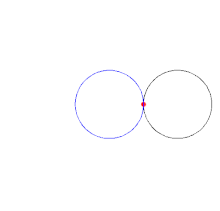
The name was coined by de Castillon in 1741[2] but had been the subject of study decades beforehand.[3] Named for its heart-like form, it is shaped more like the outline of the cross section of a round apple without the stalk.
A cardioid microphone exhibits an acoustic pickup pattern that, when graphed in two dimensions, resembles a cardioid (any 2d plane containing the 3d straight line of the microphone body). In three dimensions, the cardioid is shaped like an apple centred around the microphone which is the "stalk" of the apple.
Equations
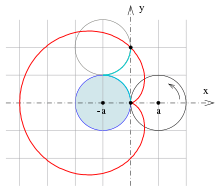
Let be the common radius of the two generating circles with midpoints , the rolling angle and the origin the starting point (see picture). One gets the
- parametric representation:
and herefrom the representation in
- polar coordinates:
- .
Introducing the substitutions and one gets after removing the square root the implicit representation in
- cartesian coordinates:
- .
Proof for the parametric representation
A proof can be established using complex numbers and their common description as the complex plane. The rolling movement of the black circle on the blue one can be split into two rotations. In the complex plane a rotation around point (origin) by an angle can be performed by the multiplication of a point (complex number) by . Hence the
- rotation around point is,
- rotation around point is: .
A point of the cardioid is generated by rotating the origin around point and subsequent rotating around by the same angle :
- .
From here one gets the parametric representation above:
(The following formulae were used. See trigonometric functions.)
Metric properties
For the cardioid as defined above the following formulas hold:
- area ,
- arc length and
- radius of curvature
The proofs of these statement use in both cases the polar representation of the cardioid. For suitable formulas see polar coordinate system (arc length) and polar coordinate system (area)
- proof of the area formula
- .
- proof of the arc length formula
- .
- proof for the radius of curvature
The radius of curvature of a curve in polar coordinates with equation is (s. curvature)
For the cardioid one gets
Properties

Chords through the cusp
- C1: chords through the cusp of the cardioid have the same length .
- C2: The midpoints of the chords through the cusp lie on the perimeter of the fixed generator circle (see picture) .
- proof for C1
The points are on a chord through the cusp (=origin). Hence
-
- .
- proof for C2
For the proof the representation in the complex plane (see above) is used. For the points
- ,
the midpoint of the chord is
which lies on the perimeter of the circle with midpoint and radius (see picture).
Cardioid as inverse curve of a parabola
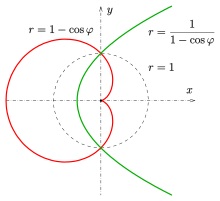
- A cardioid is the inverse curve of a parabola with its focus at the center of inversion (see graph)
For the example shown in the graph the generator circles have radius . Hence the cardioid has the polar representation
and its inverse curve
- ,
which is a parabola (s. parabola in polar coordinates) with the equation in cartesian coordinates.
Remark: Not every inverse curve of a parabola is a cardioid. For example, if a parabola is inverted across a circle whose center lies at the vertex of the parabola, then the result is a cissoid of Diocles.
Cardioid as envelope of a pencil of circles

In the previous section if one inverts additionally the tangents of the parabola one gets a pencil of circles through the center of inversion (origin). A detailed consideration shows: The midpoints of the circles lie on the perimeter of the fixed generator circle. (The generator circle is the inverse curve of the parabolas's directrix.)
This property gives rise to the following simple method to draw a cardioid:
- 1) Choose a circle and a point on its perimeter,
- 2) draw circles containing with centers on , and
- 3) draw the envelope of these circles.
- proof with envelope condition
The envelope of the pencil of implicitly given curves
with parameter consists of such points which are solutions of the non-linear system
( means the partial derivative for parameter .
Let be the circle with midpoint and radius . Then has parametric representation . The pencil of circles with centers on containing point can be represented implicitly by
- ,
which is equivalent to
The second envelope condition is
- .
One easily checks that the points of the cardioid with the parametric representation
fulfill the non-linear system above. The parameter is identical to the angle parameter of the cardioid.
Cardioid as envelope of a pencil of lines
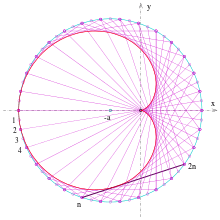
A similar and simple method to draw a cardioid uses a pencil of lines. It is due to L. Cremona:
- Draw a circle, divide its perimeter into equal spaced parts with points (s. picture) and number them consecutively.
- Draw the chords: . (i.e.: The second point is moved by double velocity.)
- The envelope of these chords is a cardioid.

- proof
The following consideration uses trigonometric formulae for . In order to keep the calculations simple, the proof is given for the cardioid with polar representation (see section Cardioids in different positions).
- equation of the tangent
of the cardioid with polar representation :
- From the parametric representation
one gets the normal vector . The equation of the tangent is:
With help of trigonometric formulae and subsequent division by , the equation of the tangent can be rewritten as:
- equation of the chord
of the circle with midpoint and radius : For the equation of the secant line passing the two points one gets:
With help of trigonometric formulae and the subsequent division by the equation of the secant line can be rewritten by:
Despite the two angles have different meanings (s. picture) one gets for the same line. Hence any secant line of the circle, defined above, is a tangent of the cardioid, too:
- The cardioid is the envelope of the chords of a circle.
Remark:
The proof can be performed with help of the envelope conditions (see previous section) of an implicit pencil of curves:
- is the pencil of secant lines of a circle (s. above) and
For fixed parameter t both the equations represent lines. Their intersection point is
- ,
which is a point of the cardioid with polar equation

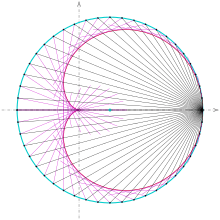
Cardioid as caustic of a circle
The considerations made in the previous section give a proof for the fact, that the caustic of a circle with light source on the perimeter of the circle is a cardioid.
- If in the plane there is a light source on the perimeter of a circle which is reflecting any ray, then the reflected rays within the circle are tangents of a cardioid.
- proof
As in the previous section the circle may have midpoint and radius . Its parametric representation is
The tangent at circle point has normal vector . Hence the reflected ray has the normal vector (see graph) and contains point . The reflected ray is part of the line with equation (see previous section)
which is tangent of the cardioid with polar equation
from the previous section.
Remark: For such considerations usually multiple reflections at the circle are neglected.
Cardioid as pedal curve of a circle
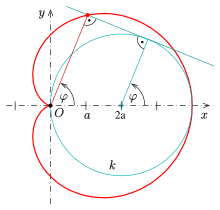
The Cremona generation of a cardioid should not be confused with the following generation:
Let be a circle and a point on the perimeter of this circle. The following is true:
- The foots of perpendiculars from point on the tangents of circle are points of a cardioid.
Hence a cardioid is a special pedal curve of a circle.
- proof
In a cartesian coordinate system circle may have midpoint and radius . The tangent at circle point has the equation
The foot of the perpendicular from point on the tangent is point with the still unknown distance to the origin . Inserting the point into the equation of the tangent yields
which is the polar equation of a cardioid.
Remark: If point is not on the perimeter of the circle , one gets a limaçon of Pascal.
The evolute of a cardioid

magenta: one point P, its centre of curvature M and its osculating circle
The evolute of a curve is the locus of centers of curvature. In detail: For a curve with radius of curvature the evolute has the representation
with the suitably oriented unit normal.
For a cardioid one gets:
- The evolute of a cardioid is another cardioid one third as large (s. picture).
- proof
For the cardioid with parametric representation
the unit normal is
and the radius of curvature
Hence the parametric equations of the evolute are
These equations describe a cardioid a third as large, rotated 180 degrees and shifted along the x-axis by .
(Trigonometric formulae were used: )
Orthogonal trajectories
An orthogonal trajectory of a pencil of curves is a curve which intersects any curve of the pencil orthogonally. For cardioids the following is true:
- The orthogonal trajectories of the pencil of cardioids with equations
- are the cardioids with equations
(The second pencil can be considered as reflections at the y-axis of the first one. See diagram.)
Proof:
For a curve given in polar coordinates by a function the following connection to cartesian coordinates hold:
and for the derivatives
Dividing the second equation by the first yields the Cartesian slope of the tangent line to the curve at the point :
For the cardioids with the equations and respectively one gets:
- and
(The slope of any curve is dependent from only, and not from the parameters !)
Hence
That means: Any curve of the first pencil intersectcs any curve of the second pencil orthogonally.
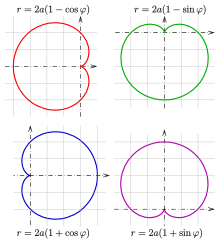
In different positions
Choosing other positions of the cardioid within the coordinate system results in different equations. The picture shows the 4 most common positions of a cardioid and their polar equations.
In complex analysis
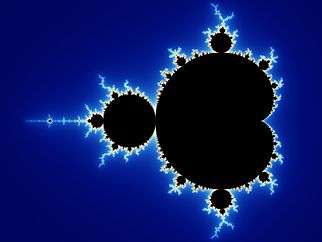
In complex analysis, the image of any circle through the origin under the map is a cardioid. One application of this result is that the boundary of the central bulb of the Mandelbrot set is a cardioid given by the equation
The Mandelbrot set contains an infinite number of slightly distorted copies of itself and the central bulb of any of these smaller copies is an approximate cardioid.

Caustics
Certain caustics can take the shape of cardioids. The catacaustic of a circle with respect to a point on the circumference is a cardioid. Also, the catacaustic of a cone with respect to rays parallel to a generating line is a surface whose cross section is a cardioid. This can be seen, as in the photograph to the right, in a conical cup partially filled with liquid when a light is shining from a distance and at an angle equal to the angle of the cone.[4] The shape of the curve at the bottom of a cylindrical cup is half of a nephroid, which looks quite similar.

See also
- Nephroid
- Deltoid
- Wittgenstein's rod
- Cardioid microphone
- Lemniscate of Bernoulli
- Loop antenna
- Radio direction finder
- Radio direction finding
- Yagi antenna
- Giovanni Salvemini
Notes
References
- R.C. Yates (1952). "Cardioid". A Handbook on Curves and Their Properties. Ann Arbor, MI: J. W. Edwards. pp. 4 ff.
- Wells D (1991). The Penguin Dictionary of Curious and Interesting Geometry. New York: Penguin Books. pp. 24–25. ISBN 0-14-011813-6.
External links
| Wikimedia Commons has media related to Cardioids. |
- "Cardioid", Encyclopedia of Mathematics, EMS Press, 2001 [1994]
- O'Connor, John J.; Robertson, Edmund F., "Cardioid", MacTutor History of Mathematics archive, University of St Andrews.
- Hearty Munching on Cardioids at cut-the-knot
- Weisstein, Eric W. "Cardioid". MathWorld.
- Weisstein, Eric W. "Epicycloid--1-Cusped". MathWorld.
- Weisstein, Eric W. "Heart Curve". MathWorld.
- Xah Lee, Cardioid (1998) (This site provides a number of alternative constructions).
- Jan Wassenaar, Cardioid, (2005)